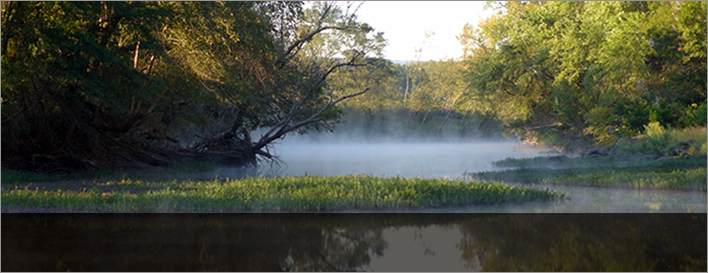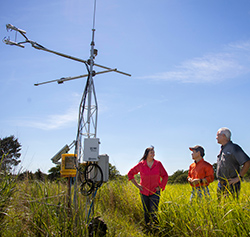Dr. Rodney Will


Dr. Rodney Will, professor of natural resource ecology and management at Oklahoma State University, is a member of the OK NSF EPSCoR Track-1 RII Award titled Socially Sustainable Solutions for Water, Carbon, and Infrastructure Resilience in Oklahoma. The $20 million research project is a social science-led, multi-disciplinary collaboration among social, physical, biological, engineering, and computational scientists. More than thirty researchers from across the state are working together on the project, which began July 1, 2020.
 Dr. Will serves as the Team Lead of Focus Area 2: Terrestrial Water & Carbon Dynamics (TWCD). Through his research, Dr. Will is working to advance the team's goal of, "collecting and calibrating data to inform management decisions that will alter ecosystem productivity and carbon storage as well as water yield for agricultural, municipal, industrial, and ecological purposes." Specifically, he is focusing on how woody plant encroachment into grasslands alters water and carbon dynamics as well as the tradeoffs between carbon gain and water use of ecosystems within Oklahoma.
Dr. Will serves as the Team Lead of Focus Area 2: Terrestrial Water & Carbon Dynamics (TWCD). Through his research, Dr. Will is working to advance the team's goal of, "collecting and calibrating data to inform management decisions that will alter ecosystem productivity and carbon storage as well as water yield for agricultural, municipal, industrial, and ecological purposes." Specifically, he is focusing on how woody plant encroachment into grasslands alters water and carbon dynamics as well as the tradeoffs between carbon gain and water use of ecosystems within Oklahoma.
The TWCD focus area is central to the wicked problems facing Oklahoma because of conflicting policy narratives that shape concerns about carbon management and risks associated with landscape management practices (e.g., wildfire risks). At the same time, linkages across the TWCD and other focus areas provide opportunities to engage key stakeholder groups in discussions addressing both problem definition and potentially sustainable solution sets. Land use/carbon cycle issues play this crucial role because of the interactions among terrestrial ecosystems and carbon and water cycling, which are in turn integral components of the other impact domains addressed in this research project.
Dr. Will's Research Interests
-
Effects of silvicultural treatments on growth, productivity, and physiology of forests and savannas
-
Effects of management and environmental change on the ecosystem carbon gain and water use
-
Woody plant encroachment effects on water and carbon cycling
-
Canopy dynamics of forest stands
-
Effects of global climate change on trees and forests
Learn more about the OK NSF EPSCoR research project.
Pictured (above): Dr. Rodney Will, along with co-researchers Drs. Gail Wilson and Chris Zou, at a monitoring site in Oklahoma.
- Nunes Biral V.C., R.E. Will, and C.B. Zou. 2019. Establishment of Quercus marilandica and Juniperus virginiana in the Tallgrass Prairie of Oklahoma Increases Litter Inputs and Soil Organic Carbon. Forests. 10:329; doi:10.3390/f10040329.
- Hoff, D.L., Will, R.E., Zou, C.B., and Lillie, N.D. 2018. Encroachment Dynamics of Juniperus virginiana and Mesic Hardwood Species into the Cross Timbers Forest of North-central Oklahoma, USA. Forests. 9:75; doi:10.3390/f9020075.
- Bracho, R., Vogel, J.G., Will, R.E., Noormets, A., Samuelson, L.J., Jokela, E.J., Gonzalez-Benecke, C.A., Gezan, S.A., Markewitz, D., Seiler, J.R., Strahm, B.D., Teskey, R.O., Fox, T.R., Kane, M.B., Laviner, M.A., McElligot, K.M., Yang, J., Lin, W., Meek, C.R., Cucinella, J., Akers, M.K., Martin, T.A. 2018. Carbon Accumulation in Loblolly Pine Plantations is Increased by Fertilization across a Soil Moisture Availability Gradient. Forest Ecology and Management. 42:39-52.
- Acharya, B.S., Halihan, T., Zou, C.B., R.E. Will. 2017. Vegetation Controls on the Spatio-temporal Heterogeneity of Deep Moisture in the Unsaturated zone: a Hydrogeophysical Evaluation. Scientific Reports. 7: 1499 | DOI:10.1038/s41598-017-01662-y.
- Stewart J.F., R.E. Will, K.M. Robertson, C.D. Nelson. 2015. Frequent Fire Protects Shortleaf Pine from Introgression by Loblolly Pine. Conservation Genetics. 16:491-495; doi: 10.1007/s10592-014-0669-x.
- Will, R.E., T.R. Fox, M. Akers, J-C Domec, E. Jokela, M. Kane, M.A. Laviner, G. Lokuta, D. Markewitz, M.A. McGuire, C. Meek, A. Noormets, L. Samuelson, J. Seiler, B. Strahm, R. Teskey, J. Vogel, E. Ward, J. West, D. Wilson, T. Martin. 2015. A Range-wide Experiment to Investigate Nutrient and Soil Moisture Interactions in Loblolly Pine Plantations. Forests. 6: 2014-2028; doi:10.3390/f6062014.
- Caterina, G.L., R.E. Will, D.J. Turton, D.S. Wilson, C.B. Zou. 2014. Water Use of Juniperus virginiana Trees Encroached into Mesic Prairies in Oklahoma, USA. Ecohydrology. 7:1124-1134 doi: 10.1002/eco.1444.
- Will, R.E., S.M. Wilson, C.B. Zou and T.C. Hennessey. 2013. Increased VPD due to Higher Temperature Leads to Greater Transpiration and Faster Mortality during Drought for Tree Seedlings Common to the Forest-grassland Ecotone. New Phytologist. 200:366-374.
- Hiers, J.K., O’Brien, J.J., Will, R.E., and Mitchell, R.J. 2007. Forest Floor Depth Mediates Understory Vigor in Xeric Pinus palustris Ecosystems. Ecological Applications. 17:806-814.
- Will, R.E., Markewitz, D., Hendrick, R.L., Meason, D.F., Crocker, T.R., and Borders, B.E. 2006. Nitrogen and Phosphorus Dynamics for a Chronosequence of Loblolly Pine Stands Receiving Fertilization and Competition Control. Forest Ecology and Management. 227:155-168.
